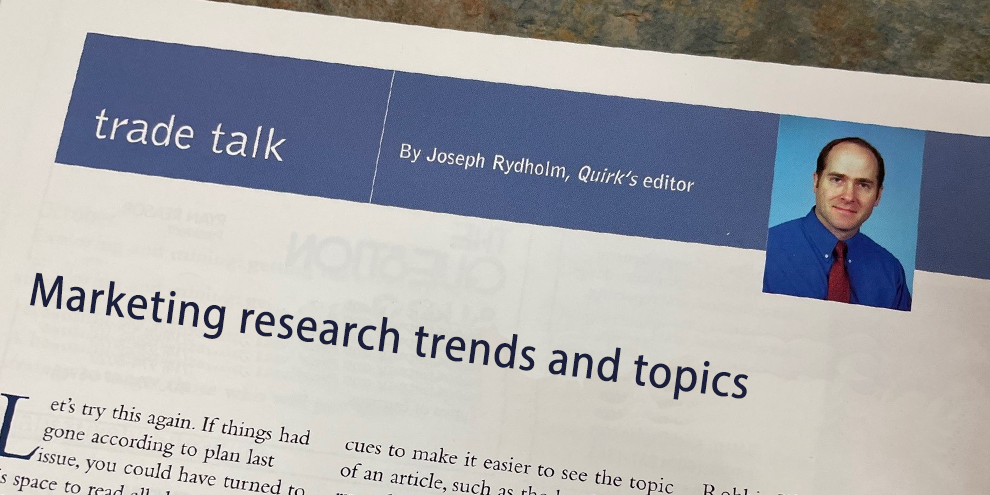The folks at Rockhopper Research, Summit, N.J., have released the results from the 2009 incarnation of the annual Research Industry Trends study and, as you might expect, positivity was in short supply.
True, respondents generally felt that the worst of the bad times are over. But more troubling is the impression that the economic pressures have driven budget-conscious non-researchers to the Web, where they have discovered that DIY research tools and plain-old scouring of the Internet can sometimes satisfy their information-gathering needs.
That kind of “Who needs a researcher?” attitude, coupled with a general sense that research company margins are too high, is enough to make the industry’s blood run cold.
The study was fielded in August and drew 512 usable responses, largely from researchers on the vendor/provider side. Respondent groupings are as follows: full-service providers made up 42.6 percent; research consultants, 25.6 percent; research client/purchaser in an enterprise, 10.9 percent; data collection, 8 percent; qualitative research provider, 5.7 percent; ad agency, 3.7 percent; and academic/non-profit/medical researcher, 3.5 percent. (I was happy, of course, to see Quirks.com again at the top of list of online sources used to locate research providers!)
No one appears particularly sanguine about the state of things.
- 73 percent felt that research is becoming commoditized and clients are less willing to pay for quality.
- 70 percent said clients are demanding shorter timelines for projects and faster delivery of findings.
- 63 percent agreed that non-researcher management are conducting their own surveys on the Web.
- 45 percent foresaw less demand for primary research, thanks to managers who think they can learn anything they need by going online.
Against that backdrop, as the study’s excellent report states it, two key questions arise: How long can a healthy industry operate on low margins with insufficient resources? And, what should be done to promote the perception that research is a valuable undertaking that requires expertise and experience and that investing in quality makes good business sense?
Driving force
Change seems to be the driving force across all techniques. While certain tried-and-true approaches are still popular, there appears to be a lot of dabbling or experimentation going on, whether it’s fueled by economic desperation (“I’ve got to find a cheaper way to get this information”), methodological curiosity or project needs.
Looking generally at usage, focus groups were used by 86 percent, same as in 2008. In-person in-depth interviews (IDIs) declined a bit to 64 percent, perhaps to the benefit of phone-based (without the Internet) IDIs, which went from 44 percent usage in 2008 to 50 percent usage in 2009.
On the quant side, Web-based surveys are still king, used by 87 percent of respondents in 2009. CATI and face-to-face/intercepts held their ground compared to 2008 usage numbers, with nearly identical 2009 figures of 60 percent and 48 percent, respectively.
Overall, respondents generally echoed 2008 sentiments when it came to the issues that affect data collection choices, citing the related bugaboos of client budgetary constraints and “the economy/business slowdown” as the two main factors.
Top issues
What are the top issues facing the industry (respondents could choose multiple responses)? Price or budget pressure from the current economic conditions (86 percent), research treated as a commodity/less willingness to pay for quality (73 percent), demands from clients for shorter timelines and faster delivery of findings (70 percent), surveys that are too long (68 percent) and non-research managers doing their own surveys on the Internet (63 percent) were some of the top-cited factors.
Many strategies were mentioned for addressing those issues, including exploring new methodologies, doing more with the same resources, exploring new technologies and exploring new sample resources. In a sign of the times, working longer hours with less staff and asking for sacrifices from vendors and employees also debuted on the list.
Looking to the future, the quantitative methodologies seen as being used more in 2010 than in 2009 included mobile phone surveys, online surveys, surveys within online communities and surveys on blogs. Those with the largest ostensible decrease in use were mail surveys, CATI, IVR, face-to-face/intercepts and CAPI.
On the qualitative side, respondents said 2010 would see increased use of interviews/groups using online communities, hybrids (two or more qualitative methods in one study), interviews using or monitoring of blogs, bulletin board studies, using panels (all kinds) for sample and chat/text-based online focus groups. Those with the highest percentage of respondents planning a decrease in use were telephone focus groups, in-person IDIs, traditional in-person focus groups and telephone IDIs.
Hopeful but unconvinced
In their general assessments of 2010, respondents typically fell into the hopeful but unconvinced camp. Forty-four percent said they expected increasing volume and research revenue/spending in the coming months but had seen no evidence of those trends yet. Equality reigned on the upper and lower ends of the optimism spectrum: 21 percent said they expected the depressed levels of revenue to continue for some time to come and 21 percent said they believed the worst was over and expected revenue and spending to increase. Let’s hope the latter camp’s prescience bears out!
(The 2009 report can be accessed free of charge at www.rockhopperresearch.com/about/index.aspx?pageID=310)
